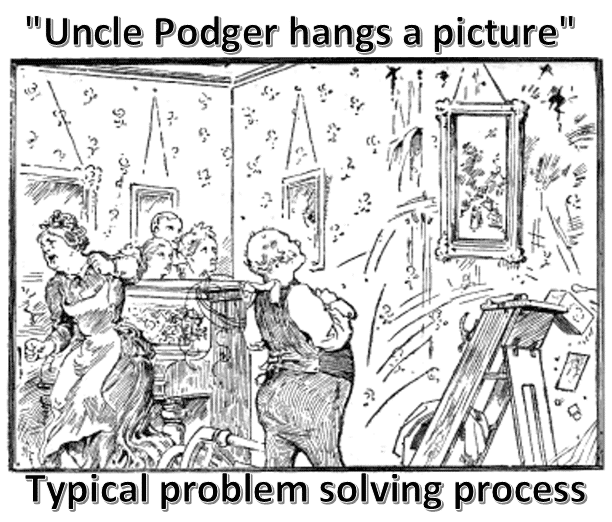People want fast and easy results without effort, but they often fail to realize that, many times, this method is more costly and the results are not as satisfactory as they could be.
It is about problem solving tools.
“You never saw such a commotion up and down a house, in all your life, as when my Uncle Podger undertook to do a job.” – this is from “Three Men in a Boat” by Jerome K. Jerome, chapter “Uncle Podger hangs a picture”.
You can enjoy reading the famous book again and again, but this particular chapter exactly corresponds to our topic, creative thinking tools.
What is most important to our topic is that Uncle Podger used tools:
“Now you go and get me my hammer, Will,” he would shout; “and you bring me the rule, Tom; and I shall want the step-ladder, and I had better have a kitchen-chair, too; and, Jim! You run round to Mr. Goggles, and tell him, ‘Pa’s kind regards, and hopes his leg’s better; and will he lend him his spirit-level?’ And don’t you go, Maria, because I shall want somebody to hold me the light; and when the girl comes back, she must go out again for a bit of picture-cord; and Tom!—where’s Tom?—Tom, you come here; I shall want you to hand me up the picture.”
While creating a lot of damages and mess, at the very end Uncle Poger finally got the expected result:
“There you are,” he would say, stepping heavily off the chair on to the charwoman’s corns, and surveying the mess he had made with evident pride. “Why, some people would have had a man in to do a little thing like that!”

Picture Ref: http://rosyhunt.blogspot.com/2013/01/uncle-podger-hangs-picture.html
The chapter “Uncle Podger hangs a picture” is a perfect example of a typical problem-solving process.
Why did Uncle Podger successfully hang a picture anyway? What was the drive to his success? The one and only thing: Uncle Podger used tools. In some cases, the tools were relevant in some cases not, but he has succeeded. He did not have enough skills to operate the tools, but he succeeded because of the tools. Without the set of the necessary tools, he would never complete the process of hanging the picture.
Now, try to imagine that Uncle John started to innovate or solve a problem, for instance, in the microelectronics or in other hi-tech processes while having no relevant skill and without using any problem-solving tools. Does anyone believe that Uncle John can succeed? Even if he got a solution, will it be the best or the optimal solution? The answer is clear – NO. The resulting situation might be much worse than the one described by Jerome K. Jerome.
Nevertheless, it is not a secret that people prefer to not use creative thinking tools. They honestly believe that they can succeed without them and even without any training or education if the field. They honestly believe that using creative thinking tools will waste their time, while they themselves can solve the problem faster.
Generally speaking, people are very often looking for applications and gadgets to make their life easier. This completely contradicts the creative thinking process. Creative thinking tools make people think and work, and that is something people don’t like doing. They like to get excellent results fast, easy, and without an effort. People want fast and easy results without effort.
Let’s try to find a root cause of this phenomenon “Why do people prefer to solve problems on their own rather than use creative thinking tools that are dedicated to the innovation process?” For this, we will use the Cause-Effect Chain (CEC) Analysis provided in PRIZ Innovation Platform.
We called our project “Creative thinking tools usage”.
On this step, there are three fields required by the platform. Indeed, these are extremely important as they help us to focus on the correct problem.
Current situation:
As a current situation, we mentioned that “There are many creative thinking tools available”. Besides new tools and concepts are being developed and their numbers increasing.
Disadvantages:
As a disadvantage, we mentioned that “People prefer to solve problems on their own rather than use creative thinking tools”. More than that, from a long experience even trainers do not always use creative thinking tools when solving a problem.
Problem statement:
As a problem statement, we choose “ People do not use creative thinking tools”.
Important note: Creative Thinking Tools in our case means any instruments developed specifically for the Innovation and Problem solving, any approaches coming out of Innovation Science and Practice.
Cause and Effect Chain(CEC) Analysis is an excellent and effective tool for the Root Cause Analysis.
The CEC Analysis is performed by consequently answering the question “Why?”. The chain continues until “Dead End” is reached, the Fundamental reason for the problem (FRP). FRP results in Fundamental Root Cause (FRC) of the problem. Typically removing of FRC does not solve the existing problem, but usually helps to prevent such problems in the future.
All intermediate links of the chain can be treated as an Auxiliary Root Causes (ARC) that if removed can help to solve the current problem but the solution does not prevent the problem from occurring in the future.
The result of our CEC analysis for the problem “People do not use creative thinking tools” is shown below:

As a Fundamental Reason for the Problem (FRP), we found: “No businesses or educational institutions promote learning and usage of creative thinking tools”.
Indeed. This is the situation, current situation. Universities are not teaching innovation and problem solving because businesses are not requiring specialists in innovation and problem-solving.
Since we got the “Dead Dnd” we can start looking for the Root Causes moving from the bottom of the chain up.
The chart below shows the results of the Root Cause analysis:

FRC could be removed if Universities and Colleges organize classes on Innovation and problem-solving. This action should increase significantly the usage of Creative Thinking tools because the students and young engineers will look for the tools at their work after graduation. In this case, corporations will be needed to acquire relevant platforms, systems or software in order to support the skilled engineers’ capability to innovate and solve problems on a professional basis.
The rest of the Root Causes are Auxiliary Root Causes (ARC): Causes ARC 1 to ARC 5, as shown above on Chart 2.
ARC 1 could be resolved by creating special working positions dedicated to innovation and problem-solving activity.
ARC 2 is removed if management will create special groups, “task-force” groups consisting of educated and trained people only, who are dedicated to innovation and solving problems.
ARC 3, ARC4 and ARC 5 can be removed if we eliminate people who are not specifically trained/educated in innovation and problem-solving processes.
Definitely, this might sound a bit harsh, but think about it for a moment, are you ready go for surgery performed by someone without the right education and training, but truly believes he can do it even better than an experienced medical doctor? It is clear, that only educated and experienced people in the specific field can act as medical doctors.
Generally speaking, the same situation occurs in all specialties, except for one – innovation and problem-solving. Unfortunately, everyone believes that he can deal with innovation and problem-solving. This is a wrong and often dangerous position. A person that has no relevant skills that do not know how to use relevant tools cannot solve any problem. Such a person can make damage.
Certainly, only professionals can make professional work. Innovation and problem solving are essential constituents of business success. Do not think that everyone who has an academic degree can succeed. He has to learn and practice creative thinking processes and tools.
In summary, here are some of the ideas and conclusions we got for our initial problem: How to promote the usage of creative thinking tools?
Discover: Does everyone want to be profitable?

The strongest recommendation to boost the usage of creative thinking tools is to prevent the participation of people without relevant training and education in innovation and problem solving processes.
DO NOT ALLOW TO INNOVATE OR SOLVE PROBLEMS TO PEOPLE WHO DO NOT KNOW HOW TO DO IT
Indeed, creative thinking tools are part of the Innovation and Problem Solving Science.
Before you start an innovation project or problem-solving process please read “Uncle Podger hangs a picture” again and remembers that you can solve a problem but you can make damage as well.
Use creative thinking tools if you are really willing to innovate or solve a problem.
LOGIN to PRIZ Innovation Platform and start your project. Remember, in Priz you’ll find tools that enhance your team’s creative processes.
Igor Polk
January 3, 2021
Every engineer is innovating and solves multitudes of problems, yet on different levels, every day of his work. But they are not trained to do it. Definitely. If they are not allowed to solve problems, then no one is available. Besides, they are only ones who know their system from many sides, and only cumulatively. None of them knows it completely. Outside people will need weeks and months or even years to get to productive level of knowledge. What to do?
The only solution is to educate EVERY engineer in problem solving tools under which, I am sure, you mean TRIZ. Then how to do that? This is a very non-trivial problem. It is a whole field of problems, most of which are social and even political. Most TRIZ practitioners do not realize it. They should.
Anatoly
January 4, 2021
Many thanks for your comment. Unfortunately, I saw a lot of times how people that think they are problem solvers completely destroy the process of innovation and problem solving. I am not sure you agree to visit a person that only believes he is a medical doctor. You will go to a real doctor.